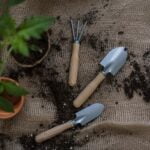Designing a small garden layout may seem like a challenging task, but with the right approach, it can become a rewarding and fulfilling project. Whether you have a tiny balcony or a limited backyard space, creating a well-designed small garden can offer numerous benefits while adding beauty and charm to your surroundings.
Small gardens matter because they provide an opportunity to make the most of limited space. In today’s fast-paced world, where urbanization is on the rise and green spaces are shrinking, small gardens offer a haven for nature lovers. These miniature oases not only bring some much-needed greenery into our lives but also serve as sanctuaries for relaxation, contemplation, and connection with nature.
A well-designed layout is crucial for maximizing the potential of your small garden. It enables you to utilize every inch effectively, ensuring that no space goes to waste. From creating captivating focal points to incorporating functional elements, such as seating areas or herb gardens, a thoughtful design can transform even the tiniest of spaces into enchanting retreats.
In the following sections, we will explore how to assess the dimensions and constraints of your small garden effectively. We will discuss how defining your needs and goals for the space can guide your design decisions. Additionally, we will delve into inspiring design ideas and themes tailored specifically for small gardens.
By choosing suitable plants for confined spaces and utilizing vertical gardening techniques, we will unlock strategies to maximize your garden’s potential. Furthermore, we will uncover ways to create eye-catching focal points and enhance the overall structure of your garden through paths, edging, and hardscapes.
Stay tuned as we dive deeper into these aspects and equip you with proven tips and tricks for maintaining your small garden efficiently. With our comprehensive guide on designing a small garden layout at hand, not only will you be able to overcome the challenges posed by limited space, but you will also witness firsthand the beauty and joy that a well-designed small garden can bring into your life.
Assessing Your Space
When designing a small garden layout, it is important to have a clear understanding of the dimensions and constraints of your space. This will allow you to make the most efficient use of the available area and ensure that your garden design is both practical and visually appealing.
Measuring Your Space
Before starting any garden design project, take measurements of your small garden. Measure the length, width, and depth of your outdoor area. This will give you an accurate idea of the total square footage you have to work with. It is also important to note any unusual features or obstacles such as slopes, trees, or existing structures that may impact your design choices.
Identifying Constraints
Understanding the constraints of your small garden is crucial in creating a successful layout. Consider factors such as sunlight exposure, soil quality, drainage issues, and access points. Take note of areas that receive full sun or shade throughout the day as this information will be essential in selecting plants that thrive in those conditions.
Additionally, determine any limitations on water availability or restrictions imposed by local regulations. These constraints will inform your choices in terms of plant selection and irrigation methods.
Considering Proportions
In a small garden, maintaining proper proportions is key to creating an aesthetically pleasing space. When choosing furniture or decorative elements for your garden, consider their size in relation to the overall dimensions of the area. Overcrowding can make a small garden feel even smaller and cluttered.
Proportions also come into play when selecting plants for your small space. Ensure that they do not outgrow their allocated area and leave room for future growth. Opting for dwarf or compact varieties can help prevent overcrowding while still adding beauty and interest to your garden.
By assessing the dimensions and constraints of your small garden, you will be able to design a layout that maximizes the potential of your space. Understanding these factors will guide your choices in terms of plant selection, furniture placement, and overall design aesthetic, resulting in a well-executed and visually pleasing small garden.
Determining Your Garden’s Purpose
When designing a small garden layout, it is important to first determine the purpose of your garden and identify your needs and goals for the space. By defining these factors, you can create a design that not only looks beautiful but also serves its intended function.
To start, make a list of what you envision for your small garden. Do you want to create a peaceful retreat where you can relax and unwind? Or perhaps you have a green thumb and want to grow your own herbs and vegetables? Whatever your goals are, writing them down will help guide your design decisions.
Next, consider the practical aspects of your garden. Are there any specific features or elements that you need to incorporate? For example, if you have children or pets, you may need to allocate an area for them to play or roam around safely. If you enjoy entertaining guests outdoors, you might want to include seating areas or an outdoor dining space.
Once you have determined the purpose of your small garden and identified your needs and goals, it’s time to start brainstorming design ideas that align with your vision. This could involve researching different garden styles such as Japanese Zen gardens, cottage gardens, or modern minimalist designs. Look for inspiration in magazines, online resources, or even by visiting nearby botanical gardens.
Getting Inspired
One of the most exciting parts of designing a small garden is exploring different design ideas and themes. This is where you can let your creativity shine and create a unique and personalized space. When it comes to small gardens, there are endless possibilities and options to choose from. Here are some tips to help you get inspired:
1. Research and gather ideas: Start by researching different garden styles and themes that appeal to you. Look for inspiration in magazines, books, online platforms, and even visit local gardens or parks for ideas. Pay attention to how they arrange plants, use colors, textures, and other design elements.
2. Consider your personal style: Think about your own preferences and personal style when choosing a theme or design idea for your small garden. Do you prefer a modern look with clean lines? Or do you lean towards a more whimsical cottage garden style? Consider what will make you feel comfortable and happy in your outdoor space.
3. Use the garden’s surroundings as inspiration: Take cues from the surrounding environment to create a cohesive design for your small garden. Is there a panoramic view that can be framed by carefully placed plants? Are there any existing features that can be incorporated into the design, such as trees or architectural elements?
Remember, the key is to choose a design idea or theme that reflects your personality and meets the needs of your space. Don’t be afraid to think outside the box and experiment with different combinations of plants, colors, materials, and accessories.
| Design Ideas | Description |
|---|---|
| Cottage Garden | A charming and romantic style characterized by an abundance of flowers, mixed borders, and informal planting. |
| Modern Minimalist | A sleek and contemporary design with clean lines, simple color palettes, and minimalistic plantings. |
| Mediterranean | Inspired by the landscapes of Mediterranean countries, this style often incorporates natural stone, terracotta pots, and drought-tolerant plants. |
Choosing the Right Plants
When selecting plants for a small garden, it is essential to consider their size and growth habits. Opt for plants that have a compact or dwarf variety, as these are more suitable for smaller spaces. Look for plants that don’t spread aggressively or require a lot of room to grow.
In addition to size, it is important to choose plants that are well-suited to the specific conditions of your small garden. Take into consideration factors such as sunlight, soil moisture, and climate. For example, if you have a shady area in your small garden, opt for shade-loving plants that will thrive in those conditions.
To make the most of your available space, consider using vertical gardening techniques. Climbing plants such as ivy or vining vegetables like tomatoes can be trained to grow up trellises or along fences, utilizing vertical space efficiently. Hanging baskets or wall-mounted planters can also be used to add more greenery without taking up valuable floor space.
When selecting plants for a small garden layout, it is also important to think about maintenance requirements. Consider how much time and effort you are willing to invest in caring for your garden. Choose low-maintenance plants that require minimal watering and pruning if you have a busy schedule or limited gardening experience.
By carefully choosing the right plants for your small garden layout, you can create an appealing and thriving space even with limited land available. Consider the size, growth habits, specific conditions of your garden, and maintenance requirements when making plant selections. With proper planning and selection, your small garden will become a beautiful oasis filled with greenery and life.
Utilizing Vertical Space
One of the key challenges when designing a small garden layout is making the most of limited space. Luckily, there are various techniques that allow you to utilize vertical space effectively and create a stunning garden even in a small area. In this section, we will explore how you can maximize space with vertical gardening techniques.
Vertical gardening is an innovative solution that involves growing plants vertically rather than horizontally. This technique not only adds visual interest to your garden but also maximizes the use of available space, making it ideal for small gardens. There are several ways to implement vertical gardening, such as using trellises, arbors, walls, or hanging baskets.
Trellises and arbors are popular options for vertical gardening as they provide support for climbing plants and vines. They can be installed against walls or fences to create a beautiful backdrop and add height to your garden. Moreover, trellises and arbors can be designed in different shapes and sizes to match the style of your garden.
Creating Focal Points
Incorporating eye-catching elements into a small garden is essential for enhancing its overall design and creating focal points. These focal points serve as visual anchors that draw attention and add interest to the space. By strategically placing unique and captivating elements, you can transform your small garden into a beautiful and inviting oasis.
Choosing the Right Focal Points
When selecting focal points for your small garden, it’s important to consider both their aesthetic appeal and how they fit within the overall design. Some popular choices for focal points include statues, water features, arbors, or unique plants with striking colors or textures. The key is to choose elements that complement the style and theme of your garden while also providing an element of surprise and intrigue.
Placing Focal Points Strategically
To effectively incorporate focal points into a small garden, placement is crucial. Consider the size and scale of the element in relation to the surrounding space so that it doesn’t overwhelm or overcrowd the area. Strategically place focal points along sightlines or at key locations in the garden where they will be easily visible from different angles. This can help create a sense of depth and perspective, making your small garden feel larger than it actually is.
Enhancing Focal Points With Surrounding Elements
To enhance the impact of your chosen focal points, surrounding them with complementary elements can further elevate their visual appeal. For example, framing a statue with lush greenery or placing colorful flowering plants around a water feature can create a harmonious and visually pleasing composition. Moreover, using lighting techniques such as spotlights or string lights can highlight these focal points even during nighttime hours, adding an enchanting touch to your small garden.
By incorporating eye-catching elements strategically into your small garden design, you can create stunning focal points that enhance its overall aesthetics. Remember to select focal points that complement your design theme, place them strategically for maximum impact, and enhance them with surrounding elements. With careful thought and planning, you can transform your small garden into a captivating and visually appealing sanctuary.
Enhancing the Structure
Adding paths, edging, and hardscapes to your small garden not only enhances its structure but also helps to define and accentuate the space. These elements play a crucial role in creating a visually appealing and well-designed layout. By incorporating paths, edging, and hardscapes into your small garden design, you can create an organized and functional space that brings out the best in your plants and overall garden aesthetic.
Paths are an essential feature of any garden as they provide a clear flow of movement within the space. In a small garden, paths can help to maximize the available area by directing foot traffic and separating different sections. When designing paths for your small garden, consider the dimensions of your space and how you want people to navigate through it.
Opt for narrow paths that allow for easy access while leaving room for plantings along the sides. Using materials such as gravel, stepping stones, or even reclaimed bricks can add texture and visual interest to your path design.
Edging is another aspect of enhancing the structure of your small garden. It serves both practical and aesthetic purposes by containing plantings within their designated borders while adding definition to the overall design. Edging prevents grass or groundcovers from creeping into flowerbeds or pathways, keeping everything neat and organized. You can use various materials for edging such as brick pavers, wooden planks, or metal strips depending on your desired style and budget.
Hardscapes refer to man-made structures within the garden that are not living elements. These can include features like patios, decks, walls, or even built-in seating areas. Incorporating hardscaping into your small garden design adds permanent structures that bring character and functionality to the space.
Consider selecting materials that complement the overall ambiance of your garden such as natural stone for a more rustic look or sleek concrete for a contemporary feel. Hardscaping elements also provide opportunities to create focal points within your garden, further enhancing its visual appeal and design.
Maintaining Your Small Garden
In conclusion, maintaining a small garden can be a rewarding experience with the right tips and tricks for efficient care and maintenance. By following these proven methods, you can ensure that your garden remains healthy and vibrant throughout the seasons.
One important aspect of maintaining a small garden is proper watering. It is essential to water your plants regularly but not excessively. Overwatering can lead to root rot and other diseases, while underwatering can cause the plants to wither and die. By understanding the specific water needs of your plants and monitoring the moisture level in the soil, you can strike the right balance for optimal growth.
Another tip for efficient garden care is regular pruning and trimming. This helps to promote healthy plant growth by removing dead or damaged branches, as well as shaping the plants for aesthetic purposes. Pruning also allows for better airflow and light penetration, preventing diseases from spreading among your plants. Regularly inspect your garden for any signs of pests or diseases, and take prompt action to prevent infestations from spreading.
Lastly, incorporating mulch into your small garden can provide numerous benefits. Mulching helps retain moisture in the soil, reduces weed growth, regulates soil temperature, and improves overall soil health. Choose organic mulch options such as wood chips or straw, which will break down over time and enrich the soil with nutrients.
By following these tips and tricks for efficient garden care and maintenance in your small space, you can create a thriving oasis that brings joy and beauty to your surroundings all year round. Remember to stay observant of your plants’ needs, prioritize regular maintenance tasks such as watering and pruning, and utilize natural solutions like mulch to promote a healthy ecosystem within your small garden.
With love and attention, even the tiniest of gardens can flourish into breathtaking displays of nature’s wonder.
Frequently Asked Questions
How Do You Make a Plan for a Small Garden?
When making a plan for a small garden, it is important to first consider the available space and its characteristics. Assess the amount of sunlight, shade, and soil conditions in different areas of the garden. Next, determine the purpose or theme of the garden – whether you want it to be a vegetable garden, a flower-filled oasis, or a combination of both.
Sketch out the layout of your garden on paper and include any existing structures or features that you want to incorporate. Consider factors like pathways, seating areas, and storage space if applicable. Lastly, research suitable plants for your specific climate and gardening skills, taking into account their growth habits, maintenance requirements, and compatibility with other plants.
How Do You Structure a Small Garden?
Structuring a small garden involves creating defined areas or zones within the limited space available. Start by dividing the garden into sections based on functionality or plant types. For example, you might have one section dedicated to growing vegetables while another area is designated for flowering plants. Consider using elements such as borders or hedges to visually separate these sections.
Additionally, create focal points within the garden by incorporating eye-catching elements like statues or water features. Utilize vertical gardening techniques by installing trellises or wall-mounted planters to maximize vertical space. Finally, ensure there is a logical flow throughout the garden by providing clear pathways that connect different areas.
How Do You Arrange Plants in a Small Garden?
Arranging plants in a small garden requires thoughtful consideration to optimize both aesthetics and practicality. Begin by grouping plants based on their height and growth habits to create visual interest and prevent overcrowding as they mature. Place taller plants at the back or center of beds and borders, while shorter ones can be positioned towards the front where they will not overshadow others.
Balance varying textures and colors throughout the garden to add depth and contrast. In terms of practicality, consider companion planting – selecting combinations of plants that benefit each other’s growth – to maximize productivity in limited space without compromising health or aesthetics. Be sure to allow enough space for plants to grow and spread, while also leaving room for maintenance activities such as watering, pruning, and harvesting.

Welcome to my gardening blog! I am passionate about plants and enjoy sharing my knowledge and experiences with others. In this blog, I will write about everything related to gardening, from tips on how to get started to updates on my own garden projects.





